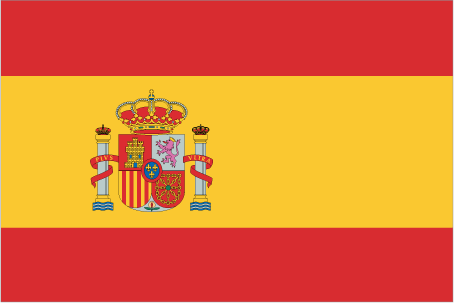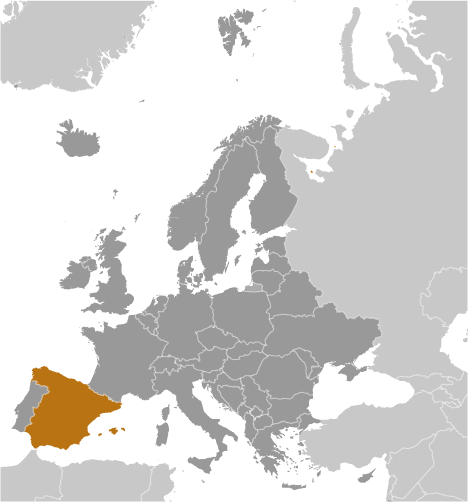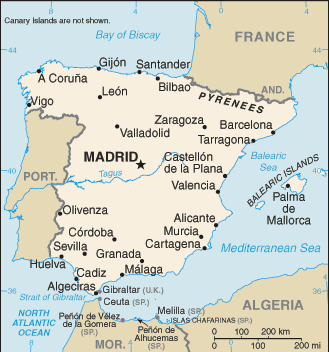|
Country name:
|

|
|
conventional long form: Kingdom of Spain
conventional short form:
Spain
local long form:
Reino de Espana
local short form:
Espana
|
|
|
Government type:
|

|
|
parliamentary monarchy
|
|
|
Capital:
|

|
|
name: Madrid
geographic coordinates:
40 24 N, 3 41 W
time difference:
UTC+1 (6 hours ahead of Washington, DC during Standard Time)
daylight saving time:
+1hr, begins last Sunday in March; ends last Sunday in October
note:
Spain is divided into two time zones including the Canary Islands
|
|
|
Administrative divisions:
|

|
|
17 autonomous communities (comunidades autonomas, singular - comunidad autonoma) and 2 autonomous cities* (ciudades autonomas, singular - ciudad autonoma); Andalucia, Aragon, Asturias, Baleares (Balearic Islands), Ceuta*, Canarias (Canary Islands), Cantabria, Castilla-La Mancha, Castilla y Leon, Cataluna (Catalonia), Comunidad Valenciana (Valencian Community), Extremadura, Galicia, La Rioja, Madrid, Melilla*, Murcia, Navarra, Pais Vasco (Basque Country)
note:
the autonomous cities of Ceuta and Melilla plus three small islands of Islas Chafarinas, Penon de Alhucemas, and Penon de Velez de la Gomera, administered directly by the Spanish central government, are all along the coast of Morocco and are collectively referred to as Places of Sovereignty (Plazas de Soberania)
|
|
|
Independence:
|

|
|
1492; the Iberian peninsula was characterized by a variety of independent kingdoms prior to the Muslim occupation that began in the early 8th century A.D. and lasted nearly seven centuries; the small Christian redoubts of the north began the reconquest almost immediately, culminating in the seizure of Granada in 1492; this event completed the unification of several kingdoms and is traditionally considered the forging of present-day Spain
|
|
|
National holiday:
|

|
|
National Day, 12 October (1492); year when Columbus first set foot in the Americas
|
|
|
Constitution:
|

|
|
approved by legislature 31 October 1978; passed by referendum 6 December 1978; signed by the king 27 December 1978
|
|
|
Legal system:
|

|
|
civil law system with regional variations
|
|
|
International law organization participation:
|

|
|
accepts compulsory ICJ jurisdiction with reservations; accepts ICCt jurisdiction
|
|
|
Suffrage:
|

|
|
18 years of age; universal
|
|
|
Executive branch:
|

|
|
chief of state: King JUAN CARLOS I (since 22 November 1975); Heir Apparent Prince FELIPE, son of the monarch, born 30 January 1968
head of government:
President of the Government (Prime Minister equivalent) Mariano RAJOY (since 20 December 2011); Vice President (and Minister of the President's Office) Soraya Saenz de SANTAMARIA (since 22 December 2011)
cabinet:
Council of Ministers designated by the president
(For more information visit the World Leaders website  ) )
note:
there is also a Council of State that is the supreme consultative organ of the government, but its recommendations are non-binding
elections:
the monarchy is hereditary; following legislative elections, the leader of the majority party or the leader of the majority coalition usually proposed president by the monarch and elected by the National Assembly; election last held on 20 November 2011 (next to be held in November 2015); vice president and Council of Ministers are appointed by the president
election results:
Mariano RAJOY elected President of the Government; percent of vote - 44.62%
|
|
|
Legislative branch:
|

|
|
bicameral; General Courts or Las Cortes Generales (National Assembly) consists of the Senate or Senado (257 seats as of 2013; 208 members directly elected by popular vote and the other 49 - as of 2013 - appointed by the regional legislatures; members to serve four-year terms) and the Congress of Deputies or Congreso de los Diputados (350 seats; each of the 50 electoral provinces fills a minimum of two seats and the North African enclaves of Ceuta and Melilla fill one seat each with members serving a four-year term; the other 248 members are determined by proportional representation based on popular vote on block lists who serve four-year terms)
elections:
Senate - last held on 20 November 2011 (next to be held by November 2015); Congress of Deputies - last held on 20 November 2011 (next to be held by November 2015)
election results:
Senate - percent of vote by party - NA; seats by party - PP 136, PSOE 48, CiU 9, Entesa (PSC-PSOE) 7, EAJ/PNV 4, other 4, members appointed by regional legislatures 49; Congress of Deputies - percent of vote by party - PP 44.6%, PSOE 28.8%, CiU 4.2%, IU 6.9%, Amaiur 1.4%, UPyD 4.7%, EAJ/PNV 1.3%, other 8.1%; seats by party - PP 186, PSOE 110, CiU 16, IU 11, Amaiur 7, UPyD 5, EAJ/PNV 5, other 10
|
|
|
Judicial branch:
|

|
|
Supreme Court or Tribunal Supremo; Constitutional Court or Tribunal Constitucioanal de Espana
|
|
|
Political parties and leaders:
|

|
|
Amaiur [collective leadership] (a coalition of parties advocating the peaceful Basque independence from Spain); Basque Nationalist Party or PNV or EAJ [Inigo URKULLU Renteria]; Canarian Coalition or CC [Claudina MORALES Rodriquez] (a coalition of five parties); Convergence and Union or CiU [Artur MAS i Gavarro] (a coalition of the Democratic Convergence of Catalonia or CDC [Artur MAS i Gavarro] and the Democratic Union of Catalonia or UDC [Josep Antoni DURAN i LLEIDA]); Entesa Catalonia de Progress (a Senate coalition grouping four Catalan parties - PSC, ERC, ICV, EUA); Galician Nationalist Bloc or BNG [Guillerme VAZQUEZ Vazquez]; Initiative for Catalonia Greens or ICV [Joan HERRERA i Torres]; Yes to the Future or Geroa Bai [collective leadership] (a coalition of four Navarran parties); Popular Party or PP [Mariano RAJOY Brey]; Republican Left of Catalonia or ERC [Oriol JUNQUERAS i Vies]; Spanish Socialist Workers Party or PSOE [Alfredo PEREZ Rubalcaba]; Union of People of Navarra or UPN [Yolanda BARCINA Angulo]; Union, Progress and Democracy or UPyD [Rosa DIEZ Gonzalez]; United Left or IU [Cayo LARA Moya] (a coalition of parties including the Communist Party of Spain or PCE and other small parties)
|
|
|
Political pressure groups and leaders:
|

|
|
Association for Victims of Terrorism or AVT (grassroots organization devoted primarily to supporting victims of the Basque Fatherland and Liberty (ETA) terrorist organization); 15-M or 15 May protest movement, which is also known as the Indignados, Spanish for the "indignant ones" (a loose association of grassroots organizations that advocate for greater accountability and transparency in Spanish politics, increased social justice and job creation); Socialist General Union of Workers or UGT and the smaller independent Workers Syndical Union or USO; Trade Union Confederation of Workers' Commissions or CC.OO.; and the smaller independent Workers Syndical Union or USO
other:
business and landowning interests; Catholic Church; free labor unions (authorized in April 1977); university students
|
|
|
International organization participation:
|

|
|
ADB (nonregional member), AfDB (nonregional member), Arctic Council (observer), Australia Group, BCIE, BIS, CAN (observer), CBSS (observer), CD, CE, CERN, EAPC, EBRD, ECB, EIB, EITI (implementing country), EMU, ESA, EU, FAO, FATF, IADB, IAEA, IBRD, ICAO, ICRM, IDA, IEA, IFAD, IFC, IFRCS, IHO, ILO, IMF, IMO, IMSO, Interpol, IOC, IOM, IPU, ISO, ITSO, ITU, ITUC (NGOs), LAIA (observer), MIGA, NATO, NEA, NSG, OAS (observer), OECD, OPCW, OSCE, Paris Club, PCA, Schengen Convention, SELEC (observer), SICA (observer), UN, UNCTAD, UNESCO, UNHCR, UNIDO, UNIFIL, Union Latina, UNRWA, UNWTO, UPU, WCO, WHO, WIPO, WMO, WTO, ZC
|
|
|
Diplomatic representation in the US:
|

|
|
chief of mission: Ambassador Ramon Gil-Casares SATRUSTEGUI
chancery:
2375 Pennsylvania Avenue NW, Washington, DC 20037
telephone:
[1] (202) 452-0100, 728-2340
FAX:
[1] (202) 833-5670
consulate(s) general:
Boston, Chicago, Houston, Los Angeles, Miami, New York, San Francisco, San Juan (Puerto Rico)
|
|
|
Diplomatic representation from the US:
|

|
|
chief of mission: Ambassador Alan D. SOLOMONT
embassy:
Serrano 75, 28006 Madrid
mailing address:
PSC 61, APO AE 09642
telephone:
[34] (91) 587-2200
FAX:
[34] (91) 587-2303
consulate(s) general:
Barcelona
|
|
|
Flag description:
|

|
|
three horizontal bands of red (top), yellow (double width), and red with the national coat of arms on the hoist side of the yellow band; the coat of arms is quartered to display the emblems of the traditional kingdoms of Spain (clockwise from upper left, Castile, Leon, Navarre, and Aragon) while Granada is represented by the stylized pomegranate at the bottom of the shield; the arms are framed by two columns representing the Pillars of Hercules, which are the two promontories (Gibraltar and Ceuta) on either side of the eastern end of the Strait of Gibraltar; the red scroll across the two columns bears the imperial motto of "Plus Ultra" (further beyond) referring to Spanish lands beyond Europe; the triband arrangement with the center stripe twice the width of the outer dates to the 18th century
note:
the red and yellow colors are related to those of the oldest Spanish kingdoms: Aragon, Castile, Leon, and Navarre
|
|
|
National symbol(s):
|

|
|
Pillars of Hercules
|
|
|
National anthem:
|

|
|
name: "Himno Nacional Espanol" (National Anthem of Spain)
lyrics/music:
none/unknown
note:
officially in use between 1770 and 1931, restored in 1939; the Spanish anthem has no lyrics; in the years prior to 1931 it became known as "Marcha Real" (The Royal March); it first appeared in a 1761 military bugle call book and was replaced by "Himno de Riego" in the years between 1931 and 1939; the long version of the anthem is used for the king, while the short version is used for the prince, prime minister, and occasions such as sporting events
|
|
|
|
|





 )
)



